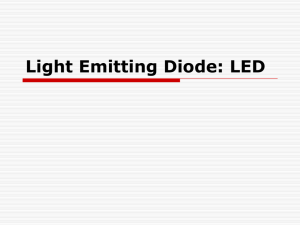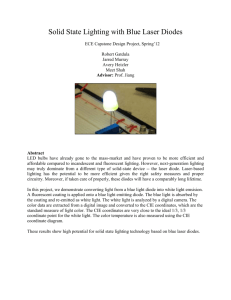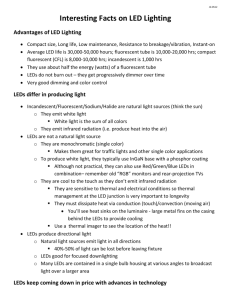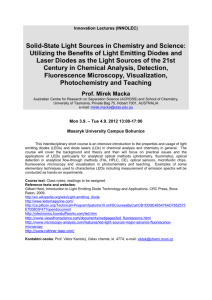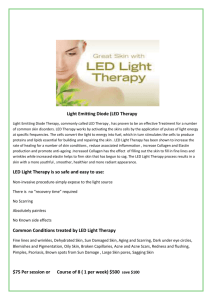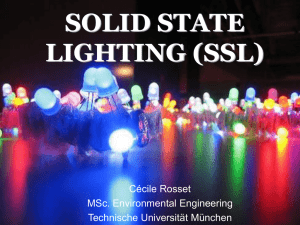Presentations\LED For Lighting Rev 1
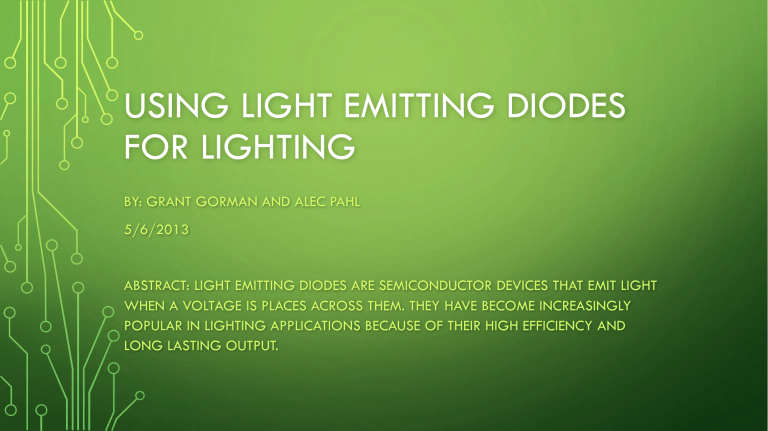
USING LIGHT EMITTING DIODES
FOR LIGHTING
BY: GRANT GORMAN AND ALEC PAHL
5/6/2013
ABSTRACT: LIGHT EMITTING DIODES ARE SEMICONDUCTOR DEVICES THAT EMIT LIGHT
WHEN A VOLTAGE IS PLACES ACROSS THEM. THEY HAVE BECOME INCREASINGLY
POPULAR IN LIGHTING APPLICATIONS BECAUSE OF THEIR HIGH EFFICIENCY AND
LONG LASTING OUTPUT.
OUTLINE
•
What is a Light Emitting Diode?
•
Why Use LEDs?
•
LED Physics
•
Lighting Applications
•
Current Progress
WHAT IS A LIGHT EMITTING DIODE?
•
A Light Emitting Diode is the reverse of a solar cell
•
It uses electrical energy to produce photons of a certain wavelength.
•
The wavelength depends on the energy gap of the material
•
λ =
ℎ𝑐
[1]
𝐸 𝑔
HOW DOES THE LIGHT EMITTING DIODE WORK?
•
Current flows in the same way as a normal diode
•
However, normal diodes made from silicon or germanium are indirect band gap materials, and when the carriers recombine, they do not form a photon
•
A light emitting diode is a direct band gap material, and when the carriers recombine, they emit a photon.
PHYSICS OF LEDS
When a voltage is applied across the pn junction of the diode, electrons and holes flow across the space charge region, becoming excess minority carriers.
These carriers then diffuse into the neutral semiconductor regions, recombining with the majority carriers.
In an LED, this process is direct from the band gap to the valence band, which causes a photon to be emitted. [1]
Figure 1: The basic process of photon generation
[2]
USING LEDS FOR LIGHTING
•
Advantages
•
More efficient: More light per unit of energy than incandescent bulbs
80-100 lm/W for LED bulbs, compared to only 10-17 lm/W for incandescent. [5]
•
Cool: Incandescent light sources can burn very hot, but a LED light source gives off little thermal heat. [6]
•
Resistant to breakage: Rather than being made of glass and thin wires, LEDs are solid state devices and are far less fragile than an incandescent bulb or fluorescent. [6]
•
Long Lasting: 30,000-50,000 hours for an LED, compared to 1,000 for incandescent or 8,000 hours for fluorescent. [2]
•
Disadvantage
•
Expensive: Per lumen, LEDs have higher upfront costs. An A19 9 LED light bulb we found cost 12.97 for each bulb, while in the same store, a six pack of A19 incandescent bulbs cost 7.97. [7]
THE COLOR OF LEDS
•
LEDs, due to the materials available and the limited number of energy gaps, only give off light in certain wavelengths; they do not give off white light naturally.
•
Two different methods are used to generate white light
•
RGB system: Mix Red, blue, and green LEDs together to create white light
•
Phosphor system: Coat LEDs in a phosphor that shifts the color into the white spectrum.
LED light bulb example
•
Lumens/Watt calculation:
• 𝐿𝑢𝑚𝑖𝑛𝑜𝑢𝑠 𝐹𝑙𝑢𝑥
𝑃𝑜𝑤𝑒𝑟
𝐶𝑜𝑛𝑠𝑢𝑚𝑝𝑡𝑖𝑜𝑛
• 800 𝑙𝑚
= 80 Lumens/Watt
10 𝑊
Table 1: Sample Data Sheet of an A19 LED light bulb [4]
OPERATING ABOVE 100 PERCENT EFFICIENCY?
•
Recent researchers at MIT found an interesting property of
LEDs [8]
•
Reducing power by a factor of 4 reduced light output by a factor of 2
•
LEDs would use electrical power to use the heat of the lattice to excite electrons
•
At very low voltages, the heat of the lattice generating photons is greater than the energy put into the diode
•
30 picowatts of input power generated 70 picowatts of light energy.
•
This also cools the air around the light
INPUT POWER VS OUPTPUT POWER AT EXTREMELY
LOW INPUTS [8]
CONCLUSIONS
•
A Light Emitting Diode is a solid state semiconductor device that converts electrical power into light via the emission of photons
•
LEDs have many advantages in lighting today, due to their high efficiency and longevity
•
However, they are more expensive up front than incandescent and fluorescents at the moment, and so require additional research before completely replacing other forms of lighting.
REFERENCES
1.
Neamen, Donald A. Semiconductor Physics and Devices. 4th ed. New York, NY: McGraw Hill, 2012. Print.
2.
"Light-emitting Diode." Wikipedia. Wikimedia Foundation, 05 Feb. 2013. Web. 02 May 2013.
<http://en.wikipedia.org/wiki/Light-emitting_diode>.
3.
"LED Lamp." Wikipedia. Wikimedia Foundation, 05 Jan. 2013. Web. 02 May 2013.
<http://en.wikipedia.org/wiki/LED_lamp>.
4.
Juan, Xiao. "LED E27 Light Bulb." Paralight.us. Para Light, 11 Aug. 2011. Web. 02 May 2013.
<http://www.para.com.tw/>.
5.
5. "Incandescent Lighting." Energy Efficiency and Renewable Energy. US Department of Energy, 22 Apr.
2013. Web. 02 May 2013. <http://www.eere.energy.gov/basics/buildings/incandescent.html>.
REFERENCES
•
6. "In Depth: Advantages of LED Lighting." Energy & Power. N.p., n.d. Web. 02 May
2013. <http://energy.ltgovernors.com/in-depth-advantages-of-led-lighting.html>.
•
7. "Light Bulbs." Homedepot.com. Home Depot, n.d. Web. 02 May 2013.
•
8. Santhanam,, Parthiban B., Dodd J. Grey, Jr., and Rajeev J. Ram.
"Thermoelectrically Pumped Light-Emitting Diodes Operating above Unity
Efficiency." Phys. Rev. Lett. 108, 097403 (2012):. American Physical Society, 27 Feb.
2012. Web. 02 May 2013.
•
9. "LED (Light Emitting Diode) Bulbs." Bulbs.com. Bulbs.com, n.d. Web. 02 May 2013.
<http://www.bulbs.com/learning/led.aspx>.
KEY CONCEPTS
•
LEDs are made of direct band gap materials such as GaP
•
Wavelength of the light emitted depends on the energy gap
•
Different materials give off different colors of light
•
LEDS are more efficient and last longer than other forms of lighting, but are more expensive upfront
•
MIT Resarchers have tested LEDs that have an efficiency of above 100 percent.

